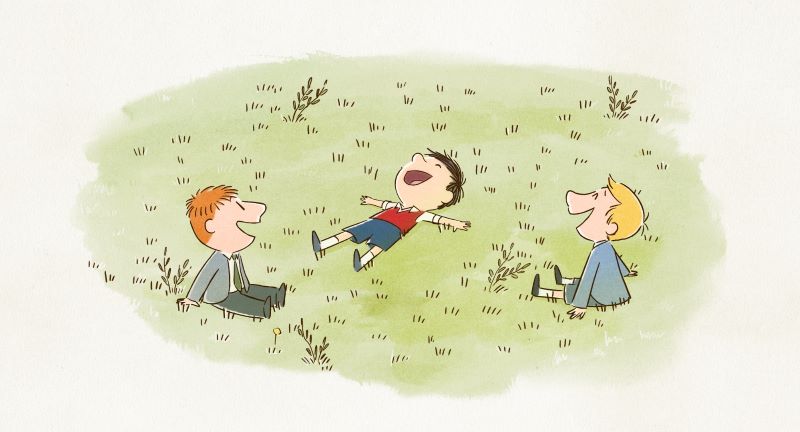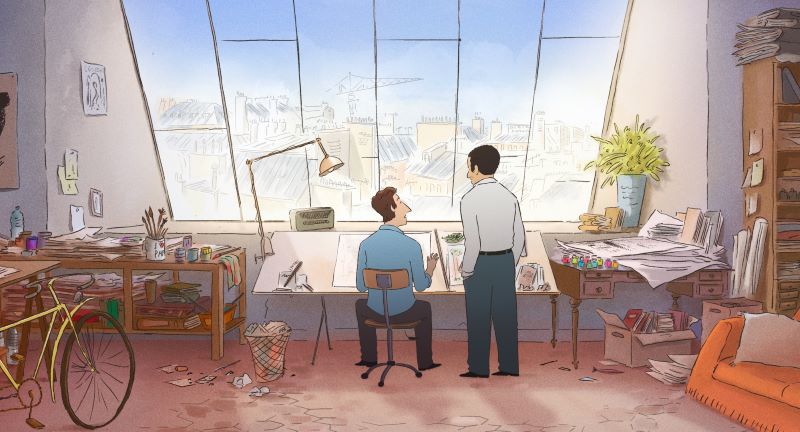
This thoroughly charming French animated feature takes a unique approach in its storytelling. Rather than solely recounting the fictional adventures of its schoolboy protagonist, the production team also incorporates the real adventures of the creators of the Nicholas character, writer Rene Goscinny and artist Jean-Jacques Sempé. Nicholas is able to move freely between his own story and the story of his creators, popping in to chat with them at various times in their history as they discuss their creative plans for him.
The Little Nicholas character first appeared in a French newspaper in 1959, eventually running for more than 222 stories that were later published as beloved books that still remain in print today. Although he’s barely known in the U.S., Nicholas books have been published in English in the past and are recent enough that they can still be tracked down for purchase by intrepid internet sleuths. The character has also been the subject of live-action film adaptations as recently as last year, further proving his enduring popularity.
Nicholas is a regular French elementary school boy living with his parents in a loving home. He is friends with lots of boys at school who aid him in typical schoolyard adventures, classroom antics, and mutual loathing of girls. He’s a little mischievous, but really more curious than malicious, making him an everyboy without any real distinguishing characteristics. The pleasure of his stories thus comes mostly from their universal and relatable appeal, not from any particularly amazing plots.

The story of his creators is relayed in a mostly positive and light-hearted manner, recounting their initial meetings with each other, their creative process as they build his world, and their reaction as the character becomes a cherished French institution as the decades roll by. They seem to have had a blissful creative relationship right up to their final dinner together shortly before the early passing of Goscinny in 1977 at 51 years old. Goscinny achieved even greater writing fame than his Little Nicholas gig thanks to his co-creation of the Asterix juggernaut and his continuation of the beloved Lucky Luke comics once the original creator relinquished writing duties. Sempé just passed away this summer, gaining U.S. acclaim for his decades of work on covers for The New Yorker.
For the film, directors Amandine Fredon and Benjamin Massoubre delineate the shift from the fictional world of Nicholas to the real world of his creators not via radically different art styles but by simply altering the coloring coverage of each scene. Nicholas scenes have watercolor washes that are generally contained within an unseen oval, making them look like magazine illustrations, while the scenes with the creators feature full bleed watercolor to the edges of the screen. It’s a genius idea that works remarkably well in helping us keep the storyline shifts straight, ensuring that we always know the difference between fact and fiction even when the Nicholas character is romping around in the “real” world.

The art style of the entire film mirrors Sempé’s original illustrations rather than updating to a different technique. The subdued watercolor look and fine line work bring to mind the aesthetics of the Ernest & Celestine movies, great company to keep. The original French voice acting is uniformly excellent, and an English dub is also available for its U.S. release.
The film was recognized as the Best Feature at this year’s prestigious Annecy International Animated Film Festival, and is currently in limited U.S. theatrical release on an Oscar-qualifying run. If you’re not able to catch the film this month, Little Nicholas is gearing up for a wider U.S. theatrical release next year, and will presumably have digital distribution after that window.